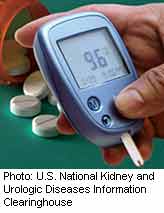Effect of intensive treatment varies for patients with low, moderate, high hemoglobin glycation index
MONDAY, April 27, 2015 (HealthDay News) — The effect of intensive versus standard type 2 diabetes treatment varies according to the hemoglobin glycation index (HGI: observed hemoglobin A1c [HbA1c] − predicted HbA1c), according to a study published online April 17 in Diabetes Care.
James M. Hempe, Ph.D., from the Louisiana State University Health Sciences Center in New Orleans, and colleagues conducted an ancillary study using data from the Action to Control Cardiovascular Risk in Diabetes randomized trial involving 10,251 patients with type 2 diabetes. Participants were randomized to standard or intensive treatment, with HbA1c goals of 7.0 to 7.9 percent and less than 6 percent, respectively. The effect of intensive treatment on outcomes was assessed in patients with low, moderate, and high HGI.
The researchers found that the primary outcomes (composite of cardiovascular events) were improved with intensive treatment in the low (hazard ratio [HR], 0.75; 95 percent confidence interval [CI], 0.59 to 0.95) and moderate (HR, 0.77; 95 percent CI, 0.61 to 0.97) HGI subgroups, but not in the high HGI subgroup (HR, 1.14; 95 percent CI, 0.93 to 1.40). Only the high HGI subgroup had higher total mortality in intensively treated patients (HR, 1.41; 95 percent CI, 1.10 to 1.80). In standard and intensive treatment groups, high HGI correlated with increased risk of hypoglycemia.
“HbA1c is not a one-size-fits-all indicator of blood glucose concentration and suggest that failure to take this into account can result in suboptimal diabetes care,” the authors write.
Copyright © 2015 HealthDay. All rights reserved.








